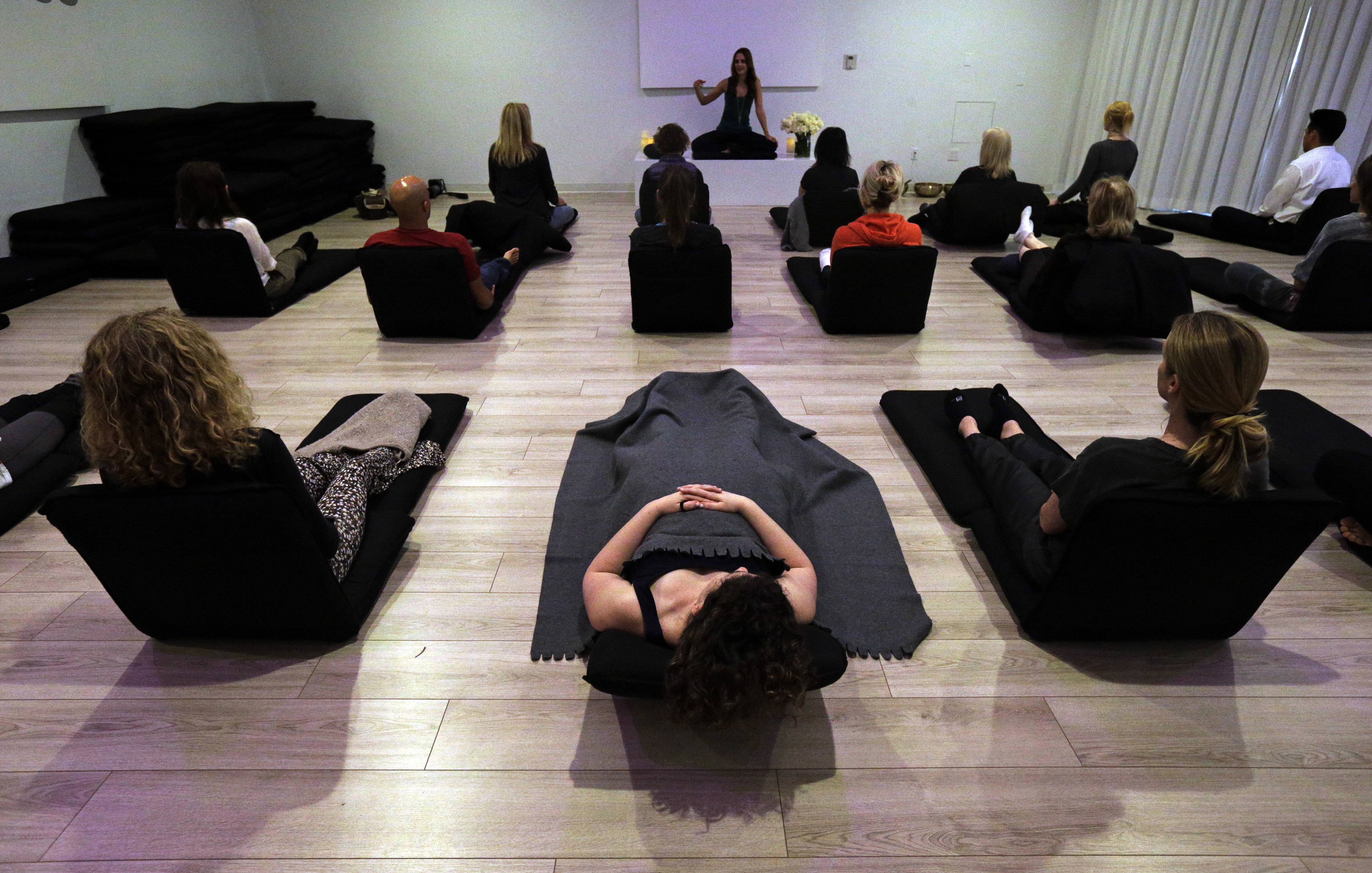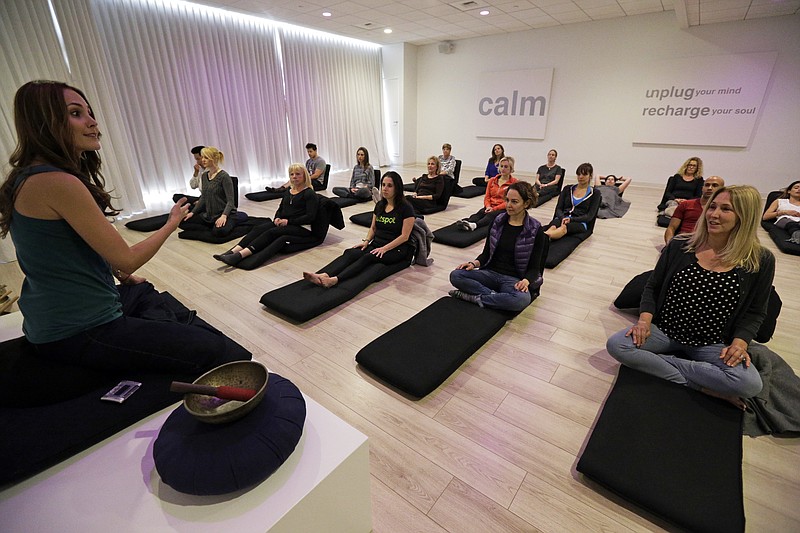 Lauren Eckstrom, background center, begins a session at Unplug Meditation Center in Los Angeles. As a distracted, multi-tasking lifestyle has given way to a more self-aware, live-in-the-moment attitude, meditation practices and mindfulness exercises have moved from hippie to mainstream. (AP Photo/Nick Ut)
Lauren Eckstrom, background center, begins a session at Unplug Meditation Center in Los Angeles. As a distracted, multi-tasking lifestyle has given way to a more self-aware, live-in-the-moment attitude, meditation practices and mindfulness exercises have moved from hippie to mainstream. (AP Photo/Nick Ut)Three ways to mindfulness
Three quick ways to meditate, practice mindfulness at work, home:Setting aside even a few minutes a day for meditation and mindfulness can sometimes feel like just one more thing to do. We asked meditation teachers from various disciplines to share some quick and easy ways to help stay grounded at work, at home or on the go.———Mindfulness At Work from Sharon Salzberg, meditation teacher and author of “Real Happiness”It’s totally private, you don’t have to sit cross-legged on the floor and start changing. No one will know you’re doing it, but breathing is a powerful, simple way to come back to yourself and center yourselfDon’t pick up the phone on the first ring. Let it ring three times, stop and breathe and then pick it up. Start to train yourself to use the sound of the phone ringing as a signal and use that time to take a breath and come back. It’s a way to cut through crazy momentum of the work day.The same can be done with email. Don’t press send right away, just take a few breaths and then read it again.—Mindfulness At Work from Sharon Salzberg, meditation teacher and author of “Real Happiness”Sit with your back supported and your head free. Check the time then close your eyes. Gently hear the word “one” in the background of your mind. You will have other thoughts and that’s OK, simply come back to the word “one” when you notice you are fantasizing about what kind of snack you would like. Don’t worry about the tempo, be easy and effortless.Check the time as often as you like while you train yourself to feel what five minutes feels like. After five minutes has passed, keep the eyes closed and let go of the word inside.Finish with a few minutes of gratitude. List the three things you are most grateful for right now. Let that bring a smile to your face. This is simple but will give your body rest so you can perform at the top of your gameThe M-Word Technique from Emily Fletcher, founder of Ziva MeditationBreak off a square of really good chocolate. Before you pick it up take a couple of deep breaths, breathe in through the nose and out through the mouth, to allow the body and mind to settle. Take a moment to appreciate the chocolate. Where has it come from? Try and imagine the different ingredients in their natural growing environment, the people who might have grown it.Before you begin to eat it, pause to notice if there’s a feeling of impatience. Is there pleasure and excitement? Or guilt or unease? Take a minute to explore it with your eyes, nose and hands. Look at it closely, smell it carefully and then touch it to see how it feels.Take a small bite, but try to resist chewing it. Notice how it feels in the mouth, the temperature and the texture. Become aware of the taste. Try to allow the chocolate to melt in the mouth by gently moving it around with your tongue, rather than chewing it.Sit back in your chair and enjoy the moment.Enjoy Your Chocolate from Andy Puddicombe, a former Buddhist monk
More Info
Learn howWhat: Mindfulness for Beginners classesWhere: Center for Mindful Living, 400 E. Main St., Suite 150.When: 6 p.m. Tuesdays, March 15-April 5.How much: $70 for non-members, $60 for members.Information: http://centerformindfulliving.wildapricot.org or 486-1279.
Drop-in meditation studios are proliferating in major cities like New York and Los Angeles and medi meet-ups are becoming the new book clubs as more people are craving ways to unplug, pushing meditation practices and mindfulness movements from hippie to mainstream. We asked leading meditation and mindfulness teachers to help demystify these ancient traditions.
What is mindfulness?
Mindfulness is staying connected to the present moment.
"You start to let go of all the accumulated stress and information. So it's not only a time to not ingest, it's a time to let the body let go," says Emily Fletcher, a former Broadway actress and founder of Ziva Meditation in New York which offers in person and online training.
Mindfulness is also a good way to curb overeating and other unhealthy habits.
Difference between mindfulness and meditation
While meditating is usually associated with a sitting practice often guided by the breath, mindfulness extends that practice into everyday life and focuses on cultivating awareness in the present. Sometimes compared to mental strength training, mindfulness can be practiced washing the dishes, driving to work, brushing your teeth and during other routine tasks. The point is to prevent your mind from wandering, projecting fear and worry from the past and future and training yourself to accept and enjoy the moment.
Why is mindfulness a buzzword?
Experts say it's the antidote to the fast-paced tech world we live in. There's slowly been a backlash against a distracted, multi-tasking lifestyle to one that is more self-aware, live in the moment attitude.
"We're just ingesting, ingesting information all day long," Fletcher says.
Adds Sharon Salzberg, a mediation teacher: "We get caught in these spirals of addiction. You remain unfulfilled. That's why we seek more and more intensity and more and more stimulation in order to feel content and it never works."
Any real health benefits?
Experts say mindfulness offers a rest for the brain, increased productivity and the ability to turn off the unfulfilling autopilot of the daily grind and instead live in the present moment.
"The mind body connection isn't just something you feel. There is a physiology that begins at the molecular level that goes all the way to the organ level," said Dr. Darshan Mehta, medical director of the Benson-Henry Institute for Mind Body Medicine at Massachusetts General Hospital. "It challenges this conventional wisdom that as we get older our brains shrink in size. That's true for most people, but for people who do have a consistent regular mind body practice that may not necessarily be the case."
It's making me feel anxious
Experts stress the importance of starting with a teacher or one of the numerous apps or online videos. For some, a YouTube meditation video or a mindfulness exercise without guidance might feel forced and unfulfilling at first.
"The more you push the mind, the more it will do the opposite," says Annelies Richmond, a director at the Art of Living Foundation, who helped bring mindfulness, meditation and yoga to New York city public schools.
Instead, mindfulness should be a natural by-product of a daily meditation practice.
"When you just tell someone just go close your eyes and meditate, it can become like a torture. There are a bunch of thoughts and you don't know want to do with them. Sometimes you feel more restless being aware of all those thoughts," says Richmond.
